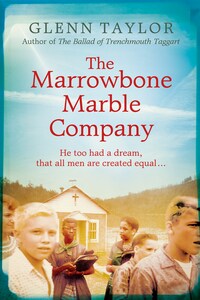The Borough Press,
An imprint of HarperCollinsPublishers
1 London Bridge Street
London SE1 9GF
www.harpercollins.co.uk
First published by HarperCollinsPublishers 2015
Copyright © Glenn Taylor 2015
Cover layout design © HarperCollins Publishers Ltd 2016.
Cover design © Mecob Design Ltd
Cover photographs © Matthias Clamer / Getty Images; CGTextures (wood planks).
Glenn Taylor asserts the moral right to be identified as the author of this work
A catalogue record for this book is available from the British Library
This novel is entirely a work of fiction. The names, characters and incidents portrayed in it are the work of the author’s imagination. Any resemblance to actual persons, living or dead, events or localities is entirely coincidental.
All rights reserved under International and Pan-American Copyright Conventions. By payment of the required fees, you have been granted the non-exclusive, non-transferable right to access and read the text of this e-book on-screen. No part of this text may be reproduced, transmitted, down-loaded, decompiled, reverse engineered, or stored in or introduced into any information storage and retrieval system, in any form or by any means, whether electronic or mechanical, now known or hereinafter invented, without the express written permission of HarperCollins e-books
Ebook Edition © July 2015 ISBN: 9780008104825
Source ISBN: 9780008104801
Version 2016-04-22
This one is for the people of McDowell County, West Virginia, past, present, and future
Cook ovens glare red-eyed upon the darkness
And belch their cinders at the fevered days.
—LOUISE MCNEILL
A man with a guitar laid flat on his lap
And a pocketknife for a slide
Called a song about old Keystone
Where the strumpets and knaves reside
Come all ye fornicators he sang
Come on Death’s Black Train
Ain’t no difference ’tween here and hell
’Cept a creek running ’side the lane
He told the tale of the Kid and the Queen
And he told what came before
The years he gave were wide apart
A season apiece made four
1877’s Fall and Winter ’97
1903 in Spring and Summer 1910
The hell he conjured was so glorious
I found salvation in every sin.
—JENKINJONES CHESTER
Though this novel is an unruly work of fiction, the reader may be best served to know a few truths. First, the last name Baach is pronounced BAY-CH. My wife Margaret’s great-great grandfather was Isaiah Lee Baach of Kermit, West Virginia, in Mingo County. He was most likely born in or around Pocahontas, Virginia, where his parents had settled after emigrating from Germany. Though I. Lee Baach was for me a starting point and a fascinating man, it is important to note that he is nowhere indicated or alluded to in the pages that follow (beyond the use of his last name), and that I have taken great liberties in the writing of this novel. Thus, all characters, their actions, and their speech are the product of my imagination and in no way represent any person, living or dead. The reader might also note that Keystone’s beginnings and explosive growth occurred slightly later than is depicted herein. Likewise, the layout and geography of the town (including its infamous red-light district, known as Cinder Bottom) was slightly altered for ease of understanding, though Keystone is not a place to be easily understood. It has been many things since its inception. The same could be said of its county, McDowell, a place that is anything but ordinary, a place I have sought to better comprehend through reading the important work listed in the acknowledgments at the end of this novel. McDowell County is a place that is often misrepresented. I invite the reader to find it.
The condemned man wore no shoes. He stood over the drain hole in his cell and hummed the low notes running swollen in his blood. He shed his trousers while he hummed, and his shirt and his undergarments too. Each he folded in a square and set upon the straw tick in the corner. The foul drain at the floor’s middle called out to him in the singing voice of his woman down the hall. He answered, a long weary-throated note, a brand of humming borne from a troublesome lot.
He was better than six foot two inches and sturdy despite incarceration. He’d turned thirty in January. Most considered him the handsomest man they’d seen, though he wore a wide scar across his jaw.
At the pith, the condemned man was good, but he’d forever run afoul of temperance and lawmen.
Daylight through the barred window marked his lower half. His feet were pale, and his pecker, in ordinary times a swag-bellied hog of considerable proportion, was, on this morning, contracted. His woman’s voice grew louder, and in his mind he could see her, and he hummed to his contracted pecker a snake-charmer tune fetched from a hoochie kootch show, and its furrows protracted, and it was made long and serpentine. And the condemned man imagined then that it grew longer still and mined the drainpipe clear to the cell of his woman, and it whispered to her there,










